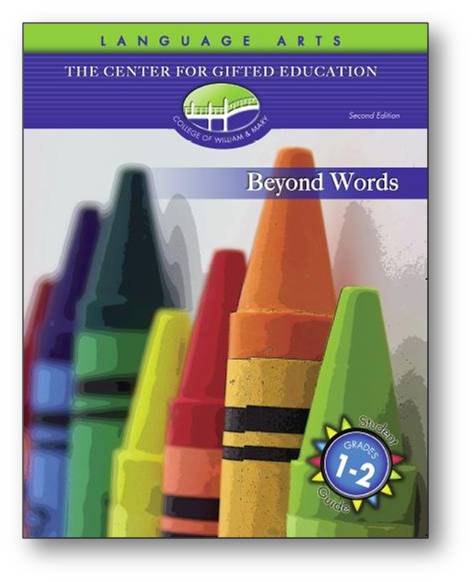In Press: CFGE Curriculum
By Dr. Kimberley L. Chandler, Curriculum Director
The “Curriculum Corner” is a blog in which I provide tips and resources for implementing the William and Mary curriculum materials and differentiating instruction for highly able students. You can locate the blog at: http://curriculumcorner.blogs.wm.edu/

Many new curriculum materials are in production at the Center for Gifted Education! I would like to spotlight items that will be available in 2012 – 2014. Because these items are still in production, please note that titles are subject to change.
Six new Navigators will be self-published by the CFGE:
- One Green Apple - Eve Bunting
- The Memory String - Eve Bunting
- Esperanza Rising - Pam Muñoz Ryan
- Riding Freedom - Pam Muñoz Ryan
- The Year of Miss Agnes - Kirkpatrick Hill
- The School Story - Andrew Clements
- Splash! Everyone into the Pool! is a unit for high-ability learners in kindergarten and first grade focusing on mathematical concepts related to linear measurement, the creativity elements of fluency and flexibility, and the overarching, interdisciplinary concept of models. The unit consists of thirteen lessons centered around the idea of designing a community pool. Students examine the question of why we measure, the importance of accuracy in measurement, and the various units and tools of measurement. The unit presents a hands-on, constructivist approach, allowing children to build their knowledge base and their skills as they explore mathematical ideas through play and planned investigations. Students are involved in creative and critical thinking, problem solving, process skill development, and communication opportunities.
- Polygons Galore! is a unit for high-ability learners in grades 3 to 5 focusing on two-dimensional and three-dimensional components of geometry by exploring polygons and polyhedra and their properties. The van Hiele levels of geometric understanding provide conceptual underpinnings for unit activities. The unit consists of nine lessons that include student discovery of properties of polygons and polyhedra, investigations for finding areas of triangles and quadrilaterals, study of the Platonic solids, and real-world applications of polygons and polyhedra. Geometry is a fundamental and powerful strand of mathematics that is the foundation for spatial reasoning. This unit includes activities related to: identifying, comparing, and analyzing polygons by using properties of the polygons; constructing meanings for geometric terms; developing strategies to find areas of specific polygons; identifying and building regular and non-regular polyhedra; and recognizing geometric ideas and relationships as applied in daily life and in other disciplines, such as art.
An elementary science unit, modeled after the Project Clarion units, is in production and will be published by Prufrock Press:
- The Earth Beneath Our Feet is a science unit designed to be used with high ability third or fourth graders. Children are fascinated with soil. They enjoy digging in the ground and take pleasure from finding things like worms, insects, fossils, and rocks within the soil. This unit builds on students’ excitement about soil through hands-on scientific investigations that help them make connections between the processes of weathering and erosion, rocks, soil, and the concept of change. The unit content expands on knowledge that students will develop in early earth science investigations. This unit emphasizes the action of weathering and erosion in the creation of soil, the negative effects of erosion on land, and provides students opportunities to explore methods that reduce the impact of erosion. Students participate in a variety of activities in which they discover the impact of natural and man-made processes on the weathering and erosion of rocks and soil and how this relates to the concept of change.
Six humanities units for students in grades 6 to 8 are being developed and will be published by Prufrock Press: (I need teachers to pilot these units. Please see my contact information below if you are interested.)
- These humanities units focus on the way in which the literature, art, and music of each decade reflect the history and events that were occurring in America at that time. These units are intended to stimulate student interest and creativity, to develop higher order thinking skills, and to promote interdisciplinary learning. The units may be used to supplement a social studies curriculum or a language arts curriculum, or could be used as stand-alone materials in a gifted education program.
The working titles for the units are:
- 1950s: Beneath the Formica: Conformity in the 1950s
- 1960s: Our Voices Will be Heard: The Movements of the 1960s
- 1970s: Taking Time Out for Me: Celebrating the Self in the 1970s
- 1980s: Climbing the Corporate Ladder and Tearing Down Walls in the 1980s
- 1990s: Speeding onto the Information Superhighway: The Explosion of New Identities in the 1990s
- 2000s: Searching for Control: Creating an Identity in the Post-9/11 World
Assessments for Highly Able Students includes sample curriculum-based assessments for use with highly able students. The assessments are compiled from the award-winning curriculum units developed at the Center for Gifted Education at the College of William and Mary. These assessments are taken from each content area and are illustrative of methods for assessing student performance in the gifted education classroom. Four new language arts units are in development. Information about them will be available in the next issue of The Bridge.
Thank you for your continued interest in our curriculum materials! For additional information, you may reach me at 757-221-2588, or at klchan@wm.edu.